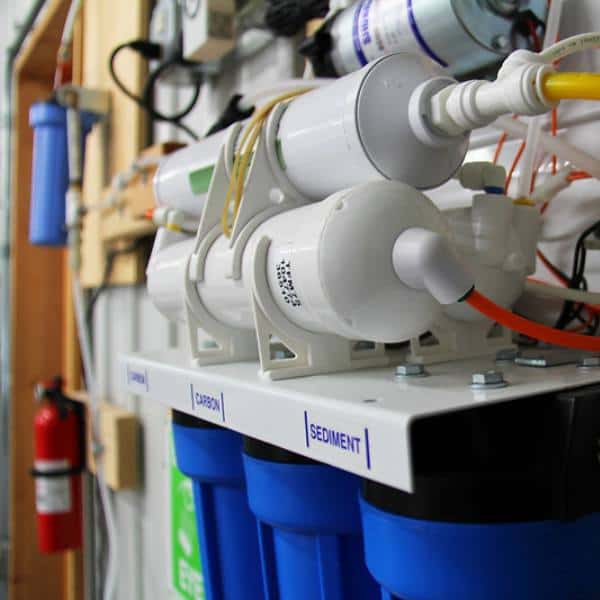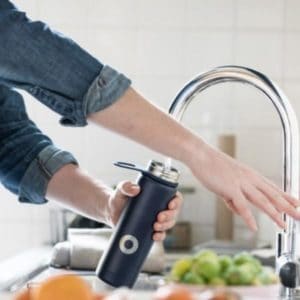Reverse Osmosis Systems
RO systems are becoming more and more popular for home water filtration, especially whole-house RO systems. It purifies water by forcing it through a semipermeable membrane. The membrane controls the size of molecules that pass through and traps larger impurities, thus producing high-quality drinking water. It is most effective at removing lead, chlorine, fluoride, nitrates, heavy metals, and other contaminants such as arsenic.
A reverse osmosis water filter is considered one of the best methods of filtration available in terms of filtration efficiency while using minimal energy and not requiring extensive maintenance costs.

Not only do reverse osmosis systems with water softeners leave tap water clean and free from contaminants, but many users also report an enhanced taste. With a reverse osmosis system, you can enjoy filtered water at any time with minimal effort.
Reverse Osmosis System Cost
Although investing in a reverse osmosis system is an upfront expense, its long-term benefits can far outweigh the cost. Reverse osmosis system cost can vary significantly – depending on size and features – but with installation included, the average price ranges from $1,500 to $10,000.
While this may seem quite an expense at first glance, it’s essential to consider that installing a reverse osmosis system can reduce or eliminate additional costs for purchasing bottled water or other additional treatments down the line.
In addition, a RO system helps reduce waste by ridding your home of unnecessary plastic bottles. All in all, investing in a reverse osmosis water system is not only beneficial for ensuring cleanse water supply throughout your home, but it also helps reduce both future household costs and your planet’s plastic footprint.
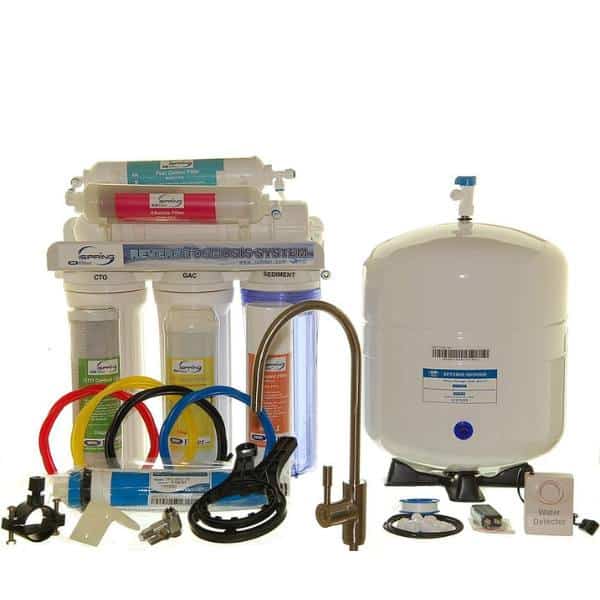
Types Of RO Water Filtration Systems
RO systems come in various shapes and sizes, making them ideal for use in households of all sizes and budgets. Smaller systems may be designed for under-sink installation, while larger capacities can filter entire buildings or larger areas. Another option is the point-of-use system which is usually installed somewhere close to the tap, such as next to your refrigerator or ice maker.
Whole House Reverse Osmosis System
On average, homeowners can expect to spend between $1,000 and $10,000 depending on the size of their home and other factors, such as what type of pre-treatment is needed. Even so, making such an investment represents a worthwhile expense that yields both immediate and long-term benefits.
Point-of-Use Reverse Osmosis System
Generally, the cost of point-of-use systems ranges greatly and depends upon factors such as type, components needed, installation labor or contractor fees, etc. On average, a POURO system will cost you anywhere from $200-$1,300 but can jump higher depending on the type of system and customization required. However, when considering the upkeep and maintenance that comes with other filtration systems – not to mention cleaner and tastier water – you’ll find that the initial investment for a POURO system is often worth it in the end.
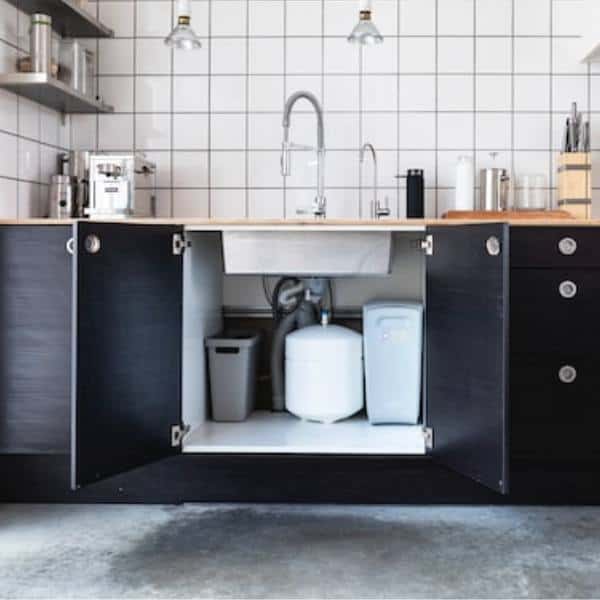
Commercial Reverse Osmosis System Cost
Reverse osmosis systems have become increasingly popular over the years due to their efficiency, effectiveness, and affordability. With a commercial reverse osmosis filtration system, businesses can save money on purchasing bottled water and improve the quality of their in-house drinking water. Of course, the cost of a commercial reverse osmosis system is an essential factor when deciding if this type of filtration is right for the business.
Fortunately, there are many types of competitively industrial reverse osmosis systems available on the market today. Depending on factors such as capacity size, efficiency, and durability, companies can find a system within their budget ranging from 4,000 – 25,000. This does not include the installation cost of between $5,00 and $2,000.
Installation Cost Of a Reverse Osmosis System
Installing the best reverse osmosis filter can be expensive, but it is often well worth the investment. The cost varies depending on whether you install the unit yourself or hire a professional to do the job, as well as any upgrades you may choose to make as part of your installation.
On average, installing a basic reverse osmosis system without considering additional items such as refrigerator water line hookups and upgraded faucets can run anywhere from $500 to $1,000.
However, the ultimate cost will depend on many factors, such as how much effort is required to run pipes and plumbing lines and the type of filter used. Make sure to consider all potential costs before making your final decision to be sure that your investment in clean drinking water is worth it!
DIY Installation Vs Hiring a Professional:
When installing reverse osmosis systems for the filtration process, there are two main options available – DIY installation or hiring a professional. Doing the work yourself could be more cost-effective but also carry a certain risk as pipes and plumbing lines may be complicated.
If you’re unsure, it’s best to consult an expert before making your final decision. In terms of hiring a professional, the cost will depend on the complexity of the job, as well as the materials and labor involved. Professional installation fees typically range from $300 to $500, but this can vary depending on your local area.
Maintenance & Operating Cost Of a Reverse Osmosis System
Once installed, countertop RO systems require very little attention. However, they do need to be maintained from time to time to ensure that it is working correctly and efficiently. The most common maintenance task is changing the filters regularly (usually every 6-12 months). On average, the cost of water and filter replacement can range from $200 to $400 per year.
In addition, to replace the reverse osmosis membrane, which is usually done every three to five years, the cost can range from $50 to $100, depending on the type of membrane.
This means that the annual cost for upkeep and maintenance of a reverse osmosis system is typically between $400-$800.

Factors That Affect The Cost Of Reverse Osmosis System
Several factors affect the reverse osmosis water cost. It is essential to understand these variables to make an informed decision and ensure you get the best deal.
Size
The size of your home will be a significant factor – larger homes need more extensive systems, resulting in higher costs.
Type
The type of filtration system you choose will also impact the cost. For example, a countertop reverse osmosis system is usually less expensive than an under-the-sink model.
Quality
The quality of components and features will impact pricing – for instance, higher-quality membranes and valves can drive up costs.
Additional Accessories
Additional accessories, such as refrigerator water line hookups or upgraded faucets, can incur additional costs.
Installation
Professional installation fees are also worth considering; without them, you may end up paying costly repair charges down the line should anything go wrong.
Filter Replacement
One of these factors includes ongoing filter replacement costs – depending on how much water you’re likely to need, this could add up to an additional expense over time. If you purchase a higher capacity machine, your filter replacement costs can be saved since it would take more time for them to get used up.
Maintenance
Another factor to consider when calculating the cost of reverse osmosis systems is maintenance – by having your system regularly serviced, you can avoid costly repairs in the future.
Utility Bills
Finally, being aware of utility bills related to electrical power may also impact the total cost of ownership for a reverse osmosis system.
Ultimately, weighing up all these aspects can help you assess which cost is most appropriate depending on your family’s needs.
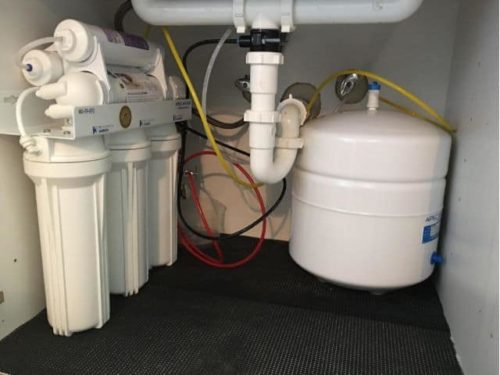
How To Do Research Before Purchasing a Reverse Osmosis System?
Researching the proper reverse osmosis system for your needs is essential to ensure you get the best solution.
- This involves considering what type of water treatment you require and determining your budget.
- You should also consider the size, features, maintenance requirements, warranty coverage, and customer service offered by different manufacturers.
- Reading reviews from previous customers can also be very helpful when researching different models. This can give you an insight into their experiences with a particular system, as well as any issues they’ve faced.
- Finally, it’s important to seek professional advice from qualified installers and technicians to ensure that the reverse osmosis system you choose is suitable for your needs. They will be able to provide you with expert advice and recommendations on the most suitable system for your home.
With a bit of research, you can make an informed decision on the right reverse osmosis system for your needs – considering all the factors mentioned above, which may affect the cost.
FAQs About Reverse Osmosis System Cost:
1) Is it worth investing in a reverse osmosis system?
Investing in a reverse osmosis system can be incredibly beneficial, as it helps to reduce contaminants from your water supply. The cost of installation and maintenance are factors that should be considered, but the long-term benefits may outweigh this initial outlay.
2) Is professional installation necessary?
Professional installation is not always necessary, as there are reverse osmosis systems available that come with easy-to-follow instructions for installation. However, professional installation is recommended to ensure your system runs efficiently and safely.
3) How often should I replace my filters?
On average, it’s recommended to replace the filter every 6-12 months. Different filters have different lifespans, so it’s important to check the manufacturer’s instructions for guidance on how often your filter should be replaced.
4) How long does a reverse osmosis membrane last?
The lifespan of a reverse osmosis membrane depends on the type and quality of the unit, but it’s usually recommended to replace the membrane every three to five years.
5) What other costs should I consider?
Aside from the initial cost of purchasing a reverse osmosis system, you should also factor in ongoing maintenance and filter replacement costs. It is also important to check utility bills related to electrical power, as this could affect the total cost of ownership for the machine.
6) What are the potential benefits of having a reverse osmosis system?
Reverse osmosis systems are incredibly beneficial and provide several advantages. These include removing contaminants from water, reducing the risk of health problems caused by drinking unfiltered water, and improving the taste of your water supply. Ultimately, investing in a reverse osmosis system can help to ensure that you and your family stay healthy.
Conclusion
In conclusion, the cost of a reverse osmosis system can vary depending on several factors, such as quality, additional accessories, installation fees, filter replacement costs, and maintenance requirements.
Carefully considering each of these elements when making your decision can help you to make an informed decision on which system is right for you. Ultimately, investing in a reverse osmosis system can be incredibly beneficial and help ensure your family stays healthy by providing them with safe and clean drinking water.
Additionally, it is important to think ahead when considering the total cost of ownership for a reverse osmosis system, as this can help you to save money and time on filter replacements and maintenance requirements.
By researching and understanding the potential costs associated with a reverse osmosis system, you can make an informed decision and enjoy the many benefits of clean water for years to come.
